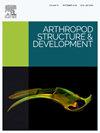基于中国和美国新附属物的核合体新资料
IF 1.3
3区 农林科学
Q2 ENTOMOLOGY
引用次数: 0
摘要
核虫属是一个相对罕见但寿命长且地理分布广泛的放射性虫属,从寒武纪第4期到冈瓦纳和劳伦西亚的德拉米安都有报道。目前已知的标本大多来自北美的五莲至德拉米安矿床,只有一个标本来自冈瓦纳第四阶段。这里报告了两个新的标本。第一个是来自中国马龙生物群(寒武系2,第3期)的C. cf. Caryosyntrips serratus附属物,这也是中国首次报道的核心体。第二附属物来自美国犹他州武流妙岭寒武系Spence页岩段,具有camurus和durus两种核合体的特征。这个新标本表明,以前用来诊断物种的特征可能反映了种内变异,然而,这一点的证实取决于新材料的发现。这些新发现将该属的时间范围扩大到寒武纪第三阶段,而马龙生物群的标本则显著扩大了该属的地理范围,这是该属首次在中国出现。除了对新材料的描述外,我们还讨论了附属物在核合虫中的功能和该属的生态学。本文章由计算机程序翻译,如有差异,请以英文原文为准。
Novel information on Caryosyntrips based on new appendages from China and the USA
Caryosyntrips is a relatively rare but long-lived and geographically widespread radiodont genus with specimens reported from Cambrian Stage 4 to the Drumian of Gondwana and Laurentia. Most of the currently known specimens are from the Wulian to Drumian deposits of North America and only one specimen is known from Stage 4 of Gondwana. Here, two new specimens are reported. The first one is a C. cf. Caryosyntrips serratus appendage from the Malong Biota of China (Cambrian, Series 2, Stage 3), which also represents the first reported occurrence of Caryosyntrips from China. The second appendage is from the Spence Shale Member (Cambrian, Miaolingian, Wuliuan) of Utah, USA and shares characters with both Caryosyntrips camurus and Caryosyntrips durus. This new specimen indicates that characters previously used to diagnose species might instead reflect intraspecific variation, however confirmation of this depends on discovery of new material. These new finds increase the temporal range of the genus into Cambrian Stage 3 and the specimen from the Malong Biota significantly increases the geographical range of the genus, with its first occurrence in China. In addition to the description of the new material we also discuss the function of the appendages in Caryosyntrips and the ecology of the genus.
求助全文
通过发布文献求助,成功后即可免费获取论文全文。
去求助
来源期刊
CiteScore
3.50
自引率
10.00%
发文量
54
审稿时长
60 days
期刊介绍:
Arthropod Structure & Development is a Journal of Arthropod Structural Biology, Development, and Functional Morphology; it considers manuscripts that deal with micro- and neuroanatomy, development, biomechanics, organogenesis in particular under comparative and evolutionary aspects but not merely taxonomic papers. The aim of the journal is to publish papers in the areas of functional and comparative anatomy and development, with an emphasis on the role of cellular organization in organ function. The journal will also publish papers on organogenisis, embryonic and postembryonic development, and organ or tissue regeneration and repair. Manuscripts dealing with comparative and evolutionary aspects of microanatomy and development are encouraged.

 求助内容:
求助内容: 应助结果提醒方式:
应助结果提醒方式:


